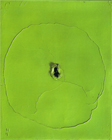Lucio Fontana (1899-1968), the subject of a small, tightly focussed and beautifully displayed exhibition at the Estorick Collection of Modern Italian Art, was an artist known for his acts of calculated violence. In the name of “Spatialism” – a new art for a new era, as he saw it – he would slash his canvases repeatedly with a razor blade, or riddle them with holes. Fontana was a contemporary of the American Abstract Expressionist, Jackson Pollock, whose skeins of flicked paint earned him the nickname of Jack the Dripper. “Lucio the Ripper”, as Fontana was once dubbed, was another ready target for satire. Italian cartoonists of the 1940s and 1950s invented fishermen who took to the sea at his approach, fearful that he might puncture the keels of their boats. They devised the Lucio Fontana parasol, pierced with multiple holes, which left sunbathers as spotted as leopards.
Fontana was well aware that, like many another artist of the avant-garde, he was all too easy to mock. In one of several texts written to justify his approach, the defiantly entitled “Why I’m a Spatial” of 1952, he railed against his light-heartedly shallow opponents: “I consider artists that smile as mediocre and imbecile those critics who write jokingly about the spatial environment.” With the passage of time, he is the one to have had the last laugh. His works, once dismissed as the antic gestures of an eccentric experimentalist, are now rightfully considered among the classic creations of twentieth-century Italian art. Fontana’s Spatial Concepts – the generic title he gave to his slashed and scarred canvases and drawings – are eloquently uneasy objects. Their forms are as elegant as their meanings are ambiguous.
Fontana was born in Argentina, to an Italian mother and an Argentinian father who was both an architect and...

Lucio Fontana: At the Roots of Spatialism
08-07-2007

